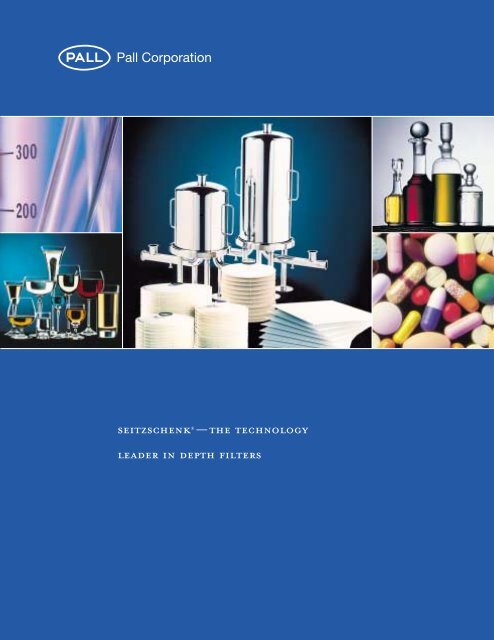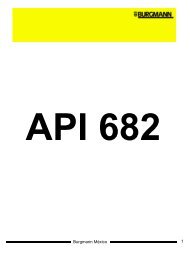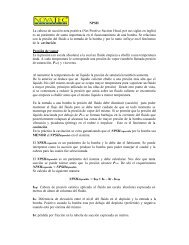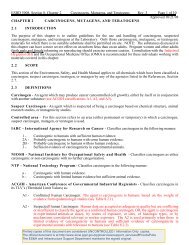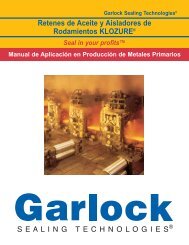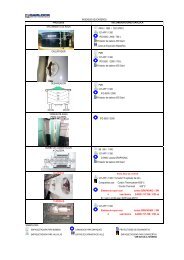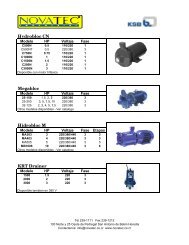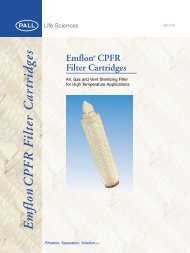the technology leader in depth filters - NOVATEC Industrial SA
the technology leader in depth filters - NOVATEC Industrial SA
the technology leader in depth filters - NOVATEC Industrial SA
You also want an ePaper? Increase the reach of your titles
YUMPU automatically turns print PDFs into web optimized ePapers that Google loves.
seitzschenk ® —<strong>the</strong> <strong>technology</strong><br />
<strong>leader</strong> <strong>in</strong> <strong>depth</strong> <strong>filters</strong>
SUPRAdisc ® modules and VELAdisc TM hous<strong>in</strong>gs offer<br />
an enclosed form of <strong>the</strong> <strong>depth</strong> filter media to simplify<br />
filter changeout and m<strong>in</strong>imize system downtime.<br />
NIRO TM Plate & Frame Filter Presses<br />
Table of Contents<br />
3 The Global Leader <strong>in</strong> Depth Filters<br />
for More Than 100 Years<br />
4 The Mechanisms of Depth Filtration<br />
5 Depth Filter Development<br />
6 Retention Characteristics<br />
7 Filter Selection<br />
8 Performance Characteristics<br />
9 K ® Series<br />
10 HSTM Series<br />
12 T TM and PTM Series<br />
14 SUPRAdur ®<br />
15 IR Series<br />
16 PVPP Series<br />
17 AKSTM Series<br />
18 PERMAdur ® and D400<br />
20 Technical Data<br />
22 Selection Guidance<br />
2
3<br />
THE GLOBAL LEADER IN DEPTH FILTERS FOR<br />
MORE THAN 100 YEARS<br />
More than 100 years ago, <strong>in</strong> 1887, SeitzSchenk developed<br />
first effective microfilter. S<strong>in</strong>ce <strong>the</strong>n, we have cont<strong>in</strong>ued to lead<br />
<strong>the</strong> way with new advancements <strong>in</strong> <strong>depth</strong> filter <strong>technology</strong>.<br />
Worldwide, SeitzSchenk is synonymous with technological<br />
<strong>in</strong>novation and high quality, dependable <strong>depth</strong> filtration products.<br />
A NEW DEFINITION FOR STATE-OF-THE-ART:<br />
At SeitzSchenk, <strong>the</strong> development of<br />
<strong>depth</strong> <strong>filters</strong> has always <strong>in</strong>volved on-go<strong>in</strong>g<br />
cooperation with our customers.<br />
The SeitzSchenk Advantage<br />
You have always been able to<br />
depend on our <strong>depth</strong> <strong>filters</strong> for:<br />
• Efficiency<br />
• Easy Handl<strong>in</strong>g<br />
• Cost Effectiveness<br />
• High Reliability<br />
• Consistent Quality<br />
All SeitzSchenk <strong>depth</strong> <strong>filters</strong> are available <strong>in</strong> both SUPRAdisc and sheet form<br />
Through extensive field tests <strong>in</strong> a wide<br />
range of applications, SeitzSchenk has<br />
established <strong>the</strong> optimal balance between<br />
special cellulose grades and specific<br />
<strong>in</strong>organic filter aids. This balance, along<br />
with <strong>the</strong> addition of polymers to provide<br />
a positive ZETA potential and o<strong>the</strong>r<br />
proprietary manufactur<strong>in</strong>g parameters, all<br />
comb<strong>in</strong>e to create a new generation of<br />
<strong>depth</strong> <strong>filters</strong>. SeitzSchenk <strong>depth</strong> <strong>filters</strong> have<br />
evolved over <strong>the</strong> years to provide higher<br />
flow rates, greater dirt-hold<strong>in</strong>g capacity,<br />
negligible filter media migration, m<strong>in</strong>imal<br />
edge leakage and longer on-stream life than<br />
competitive products.<br />
Globally, SeitzSchenk cont<strong>in</strong>ues to<br />
prove why it is <strong>the</strong> <strong>leader</strong> <strong>in</strong> <strong>depth</strong> filter<br />
<strong>technology</strong>.
SEITZSCHENK DEPTH FILTER<br />
MICROSCOPIC ENTRAPMENT<br />
STRUCTURE OF A DEPTH FILTER<br />
FLUID FILTER FLUID FILTER<br />
Type of contam<strong>in</strong>ant<br />
Contam<strong>in</strong>ant size<br />
and concentration<br />
Viscosity<br />
Fluid chemistry<br />
Contam<strong>in</strong>ant hold<strong>in</strong>g<br />
capacity<br />
Pore structure and<br />
size distribution<br />
Raw material quality<br />
Media thickness<br />
Composition<br />
THE MECHANISMS OF DEPTH FILTRATION<br />
The microscopic pore structure of a<br />
SeitzSchenk <strong>depth</strong> filter is an extremely<br />
f<strong>in</strong>e, three-dimensional sieve. It conta<strong>in</strong>s<br />
numerous, branched micro-channels<br />
to mechanically capture contam<strong>in</strong>ant.<br />
SeitzSchenk <strong>depth</strong> <strong>filters</strong> conta<strong>in</strong> 70 to<br />
85 percent void volume, a significant<br />
amount of space to trap contam<strong>in</strong>ants.<br />
The void volume of a SeitzSchenk <strong>depth</strong><br />
filter can be as high as 4 liters per square<br />
meter of filter area. The design of<br />
SeitzSchenk <strong>depth</strong> <strong>filters</strong> translates to<br />
economic value for our customers,<br />
provid<strong>in</strong>g extremely high contam<strong>in</strong>ant<br />
hold<strong>in</strong>g capacity, high flow rates and long<br />
on-stream life.<br />
In addition to mechanical removal<br />
of contam<strong>in</strong>ants, most grades of<br />
SeitzSchenk <strong>depth</strong> <strong>filters</strong> use<br />
electrok<strong>in</strong>etic attraction to enhance<br />
Test particles with a diameter of 1.05 and 1.45 µm trapped <strong>in</strong> <strong>the</strong> three-dimensional<br />
screen of a <strong>depth</strong> filter. (magnification 9500x)<br />
Fluid chemistry<br />
Contam<strong>in</strong>ant charge<br />
Contam<strong>in</strong>ant<br />
concentration<br />
Fluid pH<br />
Filtration flow rate<br />
Process temperature<br />
retention. Syn<strong>the</strong>tic polymers are added<br />
to many formulations to create a positive<br />
ZETA potential with<strong>in</strong> <strong>the</strong> filter media.<br />
Through <strong>the</strong> use of dual capture<br />
mechanisms, siev<strong>in</strong>g and adsorption,<br />
SeitzSchenk <strong>depth</strong> <strong>filters</strong> provide a<br />
filtration matrix that is highly efficient<br />
at remov<strong>in</strong>g both particles and specific<br />
impurities from <strong>the</strong> process stream.<br />
To optimize adsorption, a liquid<br />
should pass through <strong>the</strong> <strong>in</strong>numerable<br />
channels at a specific flow rate,<br />
maximiz<strong>in</strong>g contact time with <strong>the</strong><br />
filter media. Particles, microorganisms,<br />
colloids, virus and endotox<strong>in</strong>s are trapped<br />
on <strong>the</strong>ir long passage through <strong>the</strong> f<strong>in</strong>e<br />
maze. The synergy between <strong>the</strong> three<br />
dimensional filter and its ZETA potential<br />
provides enhanced removal of <strong>the</strong><br />
impurities and particles.<br />
FACTORS THAT INFLUENCE MECHANICAL RETENTION FACTORS THAT INFLUENCE ADSORPTIVE RETENTION<br />
Pore structure and<br />
size distribution<br />
Number of charged sites<br />
Nature of <strong>the</strong><br />
charge carriers<br />
Charge <strong>in</strong>tensity<br />
Polarity of <strong>the</strong><br />
charge carriers<br />
4
5<br />
Matrix of a tight cellulose fiber aggregation<br />
mixed with f<strong>in</strong>e diatomaceous earth<br />
Matrix of an agglomeration with <strong>the</strong> addition<br />
of syn<strong>the</strong>tic polymers to form a high ZETA<br />
potential<br />
Matrix of an agglomeration of<br />
specially upgraded cellulose fibers<br />
CONTINUALLY IMPROVING DEPTH FILTER TECHNOLOGY<br />
THE EARLY YEARS OF DEPTH FILTER TECHNOLOGY:<br />
Advantages<br />
• Adequate impurity and<br />
particle retention<br />
• Adequate organism<br />
reduction<br />
THE MIDDLE YEARS:<br />
Advantages<br />
• Positive ZETA potential<br />
achieved by <strong>the</strong> addition<br />
of syn<strong>the</strong>tic polymers<br />
• Increased adsorption and<br />
screen<strong>in</strong>g capabilities<br />
Advantages<br />
• Large <strong>in</strong>ternal surface area<br />
achieved by SeitzSchenk<br />
specific upgrade to <strong>the</strong><br />
cellulose fibers used <strong>in</strong><br />
our formulations<br />
• Formation of a consistent<br />
ZETA potential achieved<br />
by selective addition of<br />
syn<strong>the</strong>tic polymers<br />
• Best possible comb<strong>in</strong>ation<br />
of all material and process<br />
parameters<br />
Disadvantages<br />
• Low <strong>in</strong>ternal surface<br />
area because of<br />
<strong>the</strong> relatively large<br />
fiber dimension<br />
• High edge leakage<br />
• Premature block<strong>in</strong>g <strong>in</strong><br />
liquids with high dirt loads<br />
STATE- OF- THE- ART DEPTH FILTER TECHNOLOGY TODAY:<br />
Disadvantages<br />
• Low <strong>in</strong>ternal surface area<br />
• Potential breakthrough of impurities,<br />
particles and microorganisms if flow rate<br />
fluctuates dur<strong>in</strong>g use<br />
• Excessive b<strong>in</strong>d<strong>in</strong>g of color and active<br />
<strong>in</strong>gredients to filter media<br />
• High edge leakage
mV /V ZETA POTENTIAL<br />
-3000<br />
High ZP<br />
Media ZETA potential decreases as<br />
solution pH <strong>in</strong>creases<br />
-2000<br />
-1000<br />
0<br />
MAXIMUM RETENTION EFFICIENCY:<br />
SeitzSchenk <strong>depth</strong> <strong>filters</strong> have:<br />
• High retention capacity due to<br />
extremely f<strong>in</strong>e fibers<br />
• Positive ZETA potential <strong>in</strong><br />
polar liquids<br />
With <strong>the</strong> exception of some special<br />
grades, SeitzSchenk <strong>depth</strong> <strong>filters</strong> are<br />
positively charged. This positive charge<br />
reta<strong>in</strong>s negatively-charged particles from<br />
<strong>the</strong> filtered product and enhances <strong>the</strong><br />
<strong>depth</strong> filter’s contam<strong>in</strong>ant removal<br />
efficiency from a wide range of process<br />
fluids.<br />
Positive ZETA potential<br />
Negative ZETA potential<br />
RETENTION CHARACTERISTICS<br />
The <strong>depth</strong> filter charge is f<strong>in</strong>ely<br />
adjusted to prevent retention of color<br />
components and effective substances.<br />
With product l<strong>in</strong>e choices from n<strong>in</strong>e<br />
filter sheet series, <strong>the</strong> SeitzSchenk <strong>depth</strong><br />
filter product l<strong>in</strong>e meets <strong>the</strong> full range of<br />
process filtration requirements.<br />
CHARACTERISTIC RETENTION RATES:<br />
Depth <strong>filters</strong> reta<strong>in</strong> solids<br />
predom<strong>in</strong>antly with<strong>in</strong> <strong>the</strong> <strong>depth</strong> of <strong>the</strong><br />
matrix ra<strong>the</strong>r than on <strong>the</strong> surface.<br />
Compared with typical surface<br />
filtration, <strong>depth</strong> <strong>filters</strong> are characterized<br />
by much higher dirt-hold<strong>in</strong>g capacities<br />
and significantly longer than on-stream<br />
life. For <strong>the</strong>se reasons, <strong>depth</strong> <strong>filters</strong> are<br />
<strong>in</strong>dispensable <strong>in</strong> a variety of applications<br />
for beverage, food, pharmaceutical and<br />
biotech manufacturers.<br />
Low ZP<br />
1000 2 4 6<br />
8 10 12 pH<br />
Stream<strong>in</strong>g<br />
Current<br />
Measurement<br />
pH ........mV/V<br />
3 ............-2800<br />
4 ............-2150<br />
5 ............-1500<br />
6 ............-1250<br />
7 ............-1250<br />
8 ............-1200<br />
9 ..............-750<br />
10 ............-200<br />
11............+300<br />
Many factors <strong>in</strong>fluence <strong>the</strong> retention<br />
characteristics and filtration life of <strong>depth</strong><br />
<strong>filters</strong>. Such factors <strong>in</strong>clude <strong>the</strong>:<br />
• Shape and Concentration<br />
of <strong>the</strong> Contam<strong>in</strong>ants<br />
• Chemical Nature of <strong>the</strong><br />
Contam<strong>in</strong>ants<br />
• Fluid pH<br />
• Fluid Salt Concentration<br />
• Content of Surface-Active Substances<br />
• Temperature and Viscosity<br />
• Flow Velocity<br />
• Differential Pressure<br />
• Cont<strong>in</strong>uous or Batch Process<br />
• Prefiltration Stages<br />
Microscopic view of <strong>the</strong> cellulose fiber<br />
filter matrix. The dist<strong>in</strong>ct effect of<br />
<strong>depth</strong> comes from numerous f<strong>in</strong>ely<br />
divided maze-like channels and<br />
cavities.<br />
Microscopic morphology of perlite<br />
<strong>in</strong>organic filter aid — a key <strong>in</strong>gredient<br />
<strong>in</strong> many formulations<br />
6
7<br />
APPLICATIONS FOR DEPTH FILTERS:<br />
• Prefiltration of Liquid Processes<br />
• Clarification of Sugar Syrups<br />
• Clarification of Food Products<br />
• F<strong>in</strong>al Filtration of Liquids<br />
• Sterile Filtration of Beverages<br />
• Pyrogen Reduction<br />
• Filtration of Aggressive Fluids<br />
• Color and Taste Correction<br />
of Beverages and Syrups<br />
• Filtration of Pharmaceutical<br />
and Bio<strong>technology</strong> Products<br />
Microscopic morphology of<br />
diatomaceous earth<br />
Microscopic morphology of<br />
polyolef<strong>in</strong> fibers<br />
FILTER SELECTION<br />
Filtration requirements are determ<strong>in</strong>ed<br />
by a comb<strong>in</strong>ation of factors specific to<br />
each process. To achieve <strong>the</strong> best possible<br />
filtration results and maximum reliability,<br />
test runs under operational conditions<br />
are recommended.<br />
SeitzSchenk consultants can help<br />
you obta<strong>in</strong> maximum filtration. Our<br />
applications group can evaluate your<br />
process, your filtration goals and your<br />
process<strong>in</strong>g conditions. We can use this<br />
<strong>in</strong>formation to design and conduct<br />
filtration studies ei<strong>the</strong>r <strong>in</strong> our laboratory<br />
or on-site. This method allows us to<br />
make <strong>the</strong> best filtration recommendation<br />
to meet your requirements.<br />
Our fully qualified application<br />
specialists are readily available to assist<br />
you on-site to determ<strong>in</strong>e <strong>the</strong> best possible<br />
solution for your filtration task.<br />
DEPTH FILTERS<br />
For whatever assistance you need, our<br />
consultants are near at hand. Just contact<br />
your local SeitzSchenk representative or<br />
call <strong>the</strong> number listed on <strong>the</strong> back cover.<br />
A SELECTION OF FILTERS FOR MANY NEEDS:<br />
Filtration <strong>technology</strong> <strong>in</strong>volves many<br />
facets that cannot be addressed with one<br />
s<strong>in</strong>gle type of filter. In addition to<br />
<strong>the</strong> chemical and physical conditions<br />
affect<strong>in</strong>g filtration, <strong>the</strong> filter media must<br />
be selected to meet <strong>the</strong> <strong>in</strong>dividual<br />
application’s requirements.<br />
SeitzSchenk offers a range of <strong>depth</strong><br />
<strong>filters</strong> to accommodate <strong>the</strong> entire<br />
spectrum of applications.<br />
COMMON APPLICATION DEPTH FILTER SERIES<br />
Standard Range Filters K<br />
High Flow Food and Beverage Filters HS<br />
Pharmaceutical and Biotech Filters BIO ® *, P<br />
General <strong>Industrial</strong>-Use Filters T**<br />
Filters with Very High Wet Strength SUPRAdur **<br />
Filters for Filtration of Spirits IR<br />
Filters for Chill Haze Stabilization PVPP**<br />
Filters Conta<strong>in</strong><strong>in</strong>g Activated Carbon AKS 4, AKS 5<br />
Reusable Support<strong>in</strong>g Filters PERMAdur**, D400**<br />
*Please refer to our BIO Depth Filter Brochure for more <strong>in</strong>formation.<br />
**Please refer to our Beer, Soft Dr<strong>in</strong>ks and Sweeteners Brochures for more <strong>in</strong>formation.
CHEMICAL COMPATIBILITY:<br />
SeitzSchenk <strong>depth</strong> <strong>filters</strong> show high<br />
chemical compatibility with most<br />
aqueous and organic fluids. For detailed<br />
compatibility <strong>in</strong>formation, please call<br />
our Application Eng<strong>in</strong>eer<strong>in</strong>g Group at<br />
800-881-4917.<br />
QUALITY ASSURANCE FOR ION RELEASE LEVELS:<br />
As a standard quality assurance<br />
procedure, we use atomic absorption<br />
spectroscopy (follow<strong>in</strong>g elutriation with<br />
0.05 N H 2SO 4) to analyze every<br />
production batch of SeitzSchenk <strong>depth</strong><br />
<strong>filters</strong> for release of relevant soluble ions.<br />
Ion release <strong>in</strong>to <strong>the</strong> filtered product is<br />
considerably lower after r<strong>in</strong>s<strong>in</strong>g.<br />
Absolute quantities are a function of<br />
<strong>the</strong> r<strong>in</strong>s<strong>in</strong>g procedure, <strong>the</strong> product to be<br />
filtered and <strong>the</strong> filtration parameters,<br />
such as temperature and flow rate.<br />
ION RELEASE FROM SEITZ- EK*<br />
After Ni Cr Fe Ca Mg Al<br />
(ppm) (ppm) (ppm) (ppm) (ppm) (ppb)<br />
1 Lm 2 nm nm nm 83 16.6 17<br />
5 Lm 2 nm nm nm 23 4.6 12<br />
10 Lm 2 nm nm nm 8.8 1.8 13<br />
20 Lm 2 nm nm nm 2.81 0.52 14<br />
50 Lm 2 nm nm nm 0.72 0.12
9<br />
STANDARD DEPTH FILTERS FOR COARSE,<br />
FINE AND BIOREDUCTION FILTRATION:<br />
SeitzSchenk <strong>depth</strong> <strong>filters</strong> conta<strong>in</strong> a<br />
pronounced positive ZETA potential that<br />
forms <strong>in</strong> aqueous solutions. A <strong>depth</strong> filter’s<br />
filtration performance is determ<strong>in</strong>ed by a<br />
well-def<strong>in</strong>ed matrix of components. These<br />
<strong>in</strong>clude cellulose fibers, upgraded and f<strong>in</strong>ely<br />
fiberized by our unique process along with<br />
f<strong>in</strong>e diatomaceous earth and perlite filter<br />
aids. Thirteen different porosities, from<br />
coarse to f<strong>in</strong>e, are available.<br />
Depth Filter — Applications:<br />
• EKS ® and EK1 — Filtration for<br />
Bioreduction of Microorganisms<br />
• EK ® , KS ® 50, and KS 80 — Filtration<br />
for Removal of Yeast and F<strong>in</strong>e Particles<br />
• K100 through 900 — Filtration of<br />
Larger Particles<br />
Successful bioreduction filtration with<br />
<strong>depth</strong> <strong>filters</strong> beg<strong>in</strong>s with knowledge about<br />
<strong>the</strong> microbiological nature of <strong>the</strong> fluid.<br />
The filtration process needs to be designed<br />
and sized so that required organism removal<br />
criteria are met successfully.<br />
When us<strong>in</strong>g SeitzSchenk <strong>depth</strong><br />
<strong>filters</strong> <strong>in</strong> bioreduc<strong>in</strong>g applications, <strong>the</strong><br />
differential pressure of <strong>the</strong> filter should<br />
not exceed 22 psi (1.5 bar), and flows<br />
should not exceed 12 gph/ft 2 (525 lph/m 2 ).<br />
For handl<strong>in</strong>g difficult products, such<br />
as prote<strong>in</strong>-conta<strong>in</strong><strong>in</strong>g products, lower<br />
operat<strong>in</strong>g parameters may be needed. For<br />
additional bacterial challenge results,<br />
please refer to <strong>the</strong> Technical Data section<br />
on page 21 of this brochure.<br />
K SERIES: THE SEITZSCHENK STANDARD SERIES<br />
GPM/psid/ft 2<br />
µm<br />
20<br />
18<br />
16<br />
14<br />
12<br />
10<br />
8<br />
6<br />
4<br />
2<br />
0.8<br />
0.6<br />
0.4<br />
0.2<br />
3.0<br />
2.5<br />
2.0<br />
1.5<br />
1.0<br />
0.5<br />
TYPICAL ORGANISM CHALLENGE LIMITS ( LRV)<br />
EKS . . . . . . . . . . . . . . . . . . . . . . . . . 8.5 . . . . . . . . . . . . . . B.dim<strong>in</strong>uta<br />
EK1 . . . . . . . . . . . . . . . . . . . . . . . . . 7.5 . . . . . . . . . . . . . . B.dim<strong>in</strong>uta<br />
EK. . . . . . . . . . . . . . . . . . . . . . . . . . 7.0 . . . . . . . . . . . . . . S.marcescens<br />
KS 50 . . . . . . . . . . . . . . . . . . . . . . . 6.5 . . . . . . . . . . . . . . S.marcescens<br />
KS 80 . . . . . . . . . . . . . . . . . . . . . . . 6.0 . . . . . . . . . . . . . . S.marcescens<br />
HS 400 . . . . . . . . . . . . . . . . . . . . . . 7.0 . . . . . . . . . . . . . . S.marcescens<br />
HS 600 . . . . . . . . . . . . . . . . . . . . . . 7.0 . . . . . . . . . . . . . . S.marcescens<br />
HS 800 . . . . . . . . . . . . . . . . . . . . . . 6.5 . . . . . . . . . . . . . . S.marcescens<br />
HS 1000 . . . . . . . . . . . . . . . . . . . . . 6.0 . . . . . . . . . . . . . . S.marcescens<br />
SUPRA EK1P . . . . . . . . . . . . . . . . . 7.5 . . . . . . . . . . . . . . S.marcescens<br />
SUPRA 80P . . . . . . . . . . . . . . . . . . . 5.0 . . . . . . . . . . . . . . S.marcescens<br />
EKS P . . . . . . . . . . . . . . . . . . . . . . . 8.5 . . . . . . . . . . . . . . B.dim<strong>in</strong>uta<br />
KS 50 P . . . . . . . . . . . . . . . . . . . . . . 6.5 . . . . . . . . . . . . . . S.marcescens<br />
CHARACTERISTIC RETENTION RATES<br />
K SERIES<br />
EKS EK1 EK KS<br />
50<br />
0.05 0.07 0.12 0.16<br />
KS<br />
80<br />
K<br />
100<br />
K<br />
150<br />
K<br />
200<br />
0.19 0.25 0.31 0.36<br />
K<br />
250<br />
0.86<br />
K<br />
300<br />
1.33<br />
K<br />
700<br />
PERMEABILITIES OF SEITZSCHENK DEPTH FILTERS<br />
K SERIES<br />
1.57<br />
EKS EK1 EK KS KS K K K K K K<br />
50 80 100 150 200 250 300 700<br />
temperature: 20˚C; medium: H20<br />
*For LPM/psid/m2 , please see permeabilities <strong>in</strong>formation on chart, page 20.<br />
K<br />
800<br />
2.16<br />
K<br />
800<br />
K<br />
900<br />
2.88<br />
K<br />
900
FOOD AND BEVERAGE APPLICATIONS:<br />
HS Series filter sheets are specially<br />
formulated for <strong>the</strong> filtration of foodstuffs<br />
and beverages. Our design distributes a<br />
high filter aid concentration throughout<br />
<strong>the</strong> entire <strong>depth</strong> of <strong>the</strong> filter sheet. This<br />
filter sheet series was developed for<br />
process<strong>in</strong>g natural products which can<br />
exhibit widely variable filterability from<br />
batch to batch. HS Series sheets provide<br />
food and beverage manufactures with<br />
filtration flexibility.<br />
RECOMMENDATIONS FOR THE USE OF HS SERIES DEPTH FILTERS IN BIOREDUCTION FILTRATION<br />
DEPTH<br />
FILTER<br />
GRADE<br />
HS4000<br />
HS2000<br />
HS1600<br />
HS1000<br />
HS800<br />
HS600<br />
HS400<br />
RETENTION<br />
OF YEAST–<br />
LOW<br />
CHALLENGE<br />
● highly suitable<br />
❍ suitable – however too tight<br />
and thus reduced life<br />
— partially suitable –<br />
possibly too open<br />
●<br />
●<br />
❍<br />
❍<br />
❍<br />
❍<br />
❍<br />
RETENTION OF<br />
YEAST AND<br />
BACTERIA–LOW<br />
CHALLENGE<br />
—<br />
●<br />
●<br />
❍<br />
❍<br />
❍<br />
❍<br />
HS SERIES: HIGH FLOW FOOD AND BEVERAGE FILTERS<br />
HS Series <strong>depth</strong> <strong>filters</strong> are <strong>the</strong><br />
culm<strong>in</strong>ation of over 100 years experience<br />
<strong>in</strong> <strong>the</strong> filtration of beverages and<br />
foodstuffs. This sheet series offers high<br />
filter outputs at low filtration resistance<br />
pressures, giv<strong>in</strong>g SeitzSchenk customers<br />
dependable filtration performance <strong>in</strong> an<br />
economical way.<br />
RETENTION OF<br />
YEAST–MODERATE<br />
CHALLENGE–AS WELL<br />
AS BACTERIA–LOW<br />
CHALLENGE<br />
—<br />
●<br />
●<br />
❍<br />
❍<br />
❍<br />
RETENTION OF<br />
YEAST AND<br />
BACTERIA–<br />
MODERATE<br />
CHALLENGE<br />
RETENTION OF<br />
YEAST AND<br />
BACTERIA–<br />
HIGH<br />
CHALLENGE<br />
* Please note:<br />
Low challenge: up to approx. 250 yeast per 100 ml<br />
up to approx. 50 bacteria per 100 ml<br />
High challenge: from approx. 500 yeast per 100 ml<br />
from approx. 300 bacteria per 100 ml<br />
—<br />
●<br />
●<br />
❍<br />
❍<br />
—<br />
●<br />
●<br />
❍<br />
RETENTION OF<br />
YEAST AND<br />
BACTERIA–<br />
VERY HIGH<br />
CHALLENGE<br />
—<br />
●<br />
●<br />
RETENTION OF<br />
YEAST AND<br />
BACTERIA–<br />
EXTREME<br />
CHALLENGE<br />
—<br />
●<br />
10
11<br />
µm<br />
18<br />
16<br />
14<br />
12<br />
10<br />
8<br />
6<br />
4<br />
2<br />
0.8<br />
0.6<br />
0.4<br />
0.2<br />
CHARACTERISTIC RETENTION RATES<br />
HS SERIES SHEETS<br />
HS<br />
200<br />
HS<br />
400<br />
HS<br />
600<br />
HS<br />
800<br />
HS<br />
1000<br />
HS<br />
1600<br />
HS<br />
2000<br />
HS SERIES DEPTH FILTERS FOR BEER FILTRATION<br />
Differential pressure for all <strong>depth</strong> filter grades listed: up to 1.5 bar<br />
Flow velocities max. approx. 1.5 hL/m 2 /hr<br />
HS SERIES: HIGH FLOW FOOD AND BEVERAGE FILTERS<br />
HS<br />
4000<br />
HS<br />
6000<br />
HS<br />
9000<br />
Prefiltration after rack<strong>in</strong>g K 700<br />
F<strong>in</strong>e filtration K200<br />
Polish<strong>in</strong>g filtration prior to EK K100<br />
Steriliz<strong>in</strong>g filtration<br />
normal conditions risk of EK<br />
bacterial spoilage extreme KS50<br />
risk of bacteria spoilage<br />
Membrane prefiltration<br />
easy to filter KS80<br />
KS50<br />
difficult to filter EK<br />
extremely difficult to filter KS50<br />
Cuvée – prefiltration K 200<br />
Cuvée – f<strong>in</strong>e filtration<br />
– Charmat process KS 80<br />
– Bottle fermentation EK<br />
KS50<br />
F<strong>in</strong>ished product –<br />
prefiltration K200<br />
F<strong>in</strong>ished product –<br />
f<strong>in</strong>al filtration KS50<br />
Asti spumante EK<br />
KS50<br />
Depth filter grade<br />
Service life <strong>in</strong><br />
filtration hours*<br />
Improvement of <strong>the</strong> polish<br />
<strong>in</strong> EBC units approx.* Microbiological filtration effect<br />
HS4000 up to approx. 150 0.02 – 0.05 Removal of yeast – low challenge<br />
HS2000 up to approx. 110 0.03 – 0.06 Removal of yeast and bacteria – low challenge<br />
HS1600 up to approx. 80 0.04 – 0.10 Removal of yeast – moderate challenge as well as<br />
bacteria – low challenge<br />
HS1000 up to approx. 70 0.06 – 0.14 Removal of yeast and bacteria – moderate challenge<br />
HS800 up to approx. 50 0.08 – 0.16 Removal of yeast and bacteria – high challenge<br />
HS600 up to approx. 40 0.10 – 0.18 Removal of yeast and bacteria – very high challenge<br />
HS400 up to approx. 30 0.10 – 0.20 Removal of yeast and bacteria – (i.e. polish<strong>in</strong>g filtration)<br />
* The data quoted here are based on figures customary for production conditions <strong>in</strong> German breweries.<br />
Please contact our Application Eng<strong>in</strong>eers for assistance under your operat<strong>in</strong>g conditions.<br />
DEPTH FILTER RECOMMENDATIONS<br />
FOR THE FILTRATION OF WINE<br />
WINE APPLICATION DEPTH FILTER<br />
SPARKLING WINE APPLICATION DEPTH FILTER
T SERIES: FOR GENERAL INDUSTRIAL PURPOSES<br />
T Series <strong>depth</strong> <strong>filters</strong> are designed for<br />
general filtration applications.<br />
T 120 through T 950 are specifically<br />
designed for clarify<strong>in</strong>g filtration.<br />
Because of <strong>the</strong>ir positive ZETA<br />
potential, <strong>the</strong>se <strong>depth</strong> <strong>filters</strong> conta<strong>in</strong> a<br />
high adsorption capacity.<br />
T 1000 through T 5500 are for coarse<br />
filtration. These have no ZETA<br />
potential. This range of <strong>the</strong> T series is<br />
characterized by its open structure. Each<br />
grade <strong>in</strong> <strong>the</strong> T Series comb<strong>in</strong>es high<br />
throughput with long service life,<br />
benefits of this series’ high dirt-hold<strong>in</strong>g<br />
capacities. These <strong>filters</strong> have proven<br />
highly successful <strong>in</strong> filter<strong>in</strong>g viscous<br />
media, <strong>in</strong> reta<strong>in</strong><strong>in</strong>g gel particles<br />
and <strong>in</strong> remov<strong>in</strong>g coarsely dispersed<br />
components. These sheets are also<br />
appropriate when low filter resistance is<br />
specified. In addition, T Series sheets are<br />
suitable as support<strong>in</strong>g material for<br />
precoat filter aid filtration <strong>in</strong> plate and<br />
frame filter presses.<br />
P SERIES: FOR PHARMACEUTICAL APPLICATIONS<br />
P Series <strong>depth</strong> <strong>filters</strong> are designed for<br />
use <strong>in</strong> <strong>the</strong> pharmaceutical and biotech<br />
<strong>in</strong>dustries.<br />
Specific manufactur<strong>in</strong>g procedures<br />
and control methods guarantee a filter<br />
material low <strong>in</strong> endotox<strong>in</strong>s. Low<br />
endotox<strong>in</strong> content is confirmed through<br />
batch analysis us<strong>in</strong>g <strong>the</strong> Limulus<br />
Amoebocyte Lysate Assay procedure<br />
(LAL). Certificates document<strong>in</strong>g <strong>the</strong>se<br />
results are available upon request.<br />
T SERIES: GENERAL USE FILTERS<br />
µm<br />
80<br />
70<br />
60<br />
50<br />
40<br />
30<br />
20<br />
18<br />
16<br />
14<br />
12<br />
10<br />
8<br />
6<br />
4<br />
2<br />
µm<br />
10<br />
8<br />
6<br />
4<br />
2<br />
1<br />
0.8<br />
0.6<br />
0.4<br />
0.2<br />
T<br />
120<br />
CHARACTERISTIC RETENTION RATES<br />
T SERIES<br />
T<br />
500<br />
T<br />
750<br />
T<br />
850<br />
T<br />
950<br />
T<br />
1000<br />
T<br />
1500<br />
CHARACTERISTIC RETENTION RATES<br />
P SERIES<br />
T<br />
2100<br />
T<br />
2600<br />
T<br />
3500<br />
EKS P SUPRA EK 1 P KS 50 P SUPRA 80 P<br />
T<br />
5500<br />
12
13<br />
P Series physical data corresponds with<br />
<strong>the</strong> respective grades of <strong>the</strong> standard<br />
<strong>depth</strong> filter series. The EKS P media<br />
grade is <strong>the</strong> preferred choice when <strong>the</strong><br />
goal is maximum organism reduction. KS<br />
50 P media is an excellent prefilter for<br />
pharmaceuticals.<br />
Two SUPRA grades, SUPRA EK1P<br />
and SUPRA 80P, conta<strong>in</strong> low pyrogen<br />
levels, and are characterized by a<br />
pronounced adsorption capacity. These<br />
sheets can even reduce endotox<strong>in</strong>s<br />
<strong>in</strong> some pharmaceutical solutions.<br />
Endotox<strong>in</strong> adsorption, however,<br />
changes with electrolytes and prote<strong>in</strong><br />
concentrations.<br />
All P Series media grades are low <strong>in</strong><br />
endotox<strong>in</strong>s.<br />
GPM/psid/ft. 2<br />
45<br />
35<br />
25<br />
15<br />
5<br />
PERMEABILITIES OF SEITZSCHENK DEPTH FILTERS<br />
T SERIES<br />
5.76<br />
0.37 0.79 0.96 1.44<br />
2.88<br />
T120 T500 T750 T850 T950 T1000 T1500 T2100 T2600 T3500 T5500<br />
temperature: 20˚C; medium: H20 SUPRA EK1 P 60 0.06 3 282 282<br />
600 4 3.11 x 10 3<br />
6000 5 3.14 x 10 4<br />
6 x 10 4<br />
6 3.14 x 10 5<br />
6 x 10 5<br />
6 x 10 5<br />
0 3.14 x 10 6<br />
Lipopolysaccharide: E. coli 055:B5 Filtration flow rate: 460 L/m 2 /hr<br />
Endotox<strong>in</strong> reduction:<br />
12.4<br />
17.3 17.3<br />
21.6<br />
*For LPM/psid/m 2 , please see permeabilities <strong>in</strong>formation on chart, page 20.<br />
DEPTH FILTER ENDOTOXIN CONTENT (EU mL) LOGARITHMIC ENDOTOXIN TOTAL ENDOTOXIN<br />
UNFILTRATE FILTRATE ENDOTOXIN CHALLENGE RETENTION<br />
REDUCTION (EU/cm 2 ) (EU/cm 2 )<br />
3.11 x 10 3<br />
3.14 x 10 4<br />
3.14 x 10 5<br />
0<br />
EU/ml unfiltrate<br />
Endotox<strong>in</strong> retention:<br />
(EU/ml unfiltrate - EU/ml filtrate) x ml volume filtered<br />
EU/m/ filtrate cm2 filter area<br />
Sensitivity of reagent: 0.05 EU/ml Medium: pure water<br />
P SERIES: PHARMACEUTICAL AND BIOTECH FILTERS<br />
GPM/psid/ft. 2<br />
0.40<br />
0.30<br />
0.20<br />
0.10<br />
PERMEABILITIES OF<br />
SEITZSCHENK DEPTH FILTERS<br />
P SERIES<br />
0.05<br />
0.12<br />
0.16<br />
0.27<br />
42.4<br />
EKS P SUPRA EK1 P KS 50 P SUPRA 80 P<br />
temperature: 20˚C; medium: H20 *For LPM/psid/m 2 , please see permeabilities <strong>in</strong>formation on chart, page 20.
FOR RESISTANCE TO AGGRESSIVE CONDITIONS:<br />
SUPRAdur ® Series <strong>depth</strong> <strong>filters</strong><br />
have additional syn<strong>the</strong>tic fibers for<br />
<strong>in</strong>creased resistance aga<strong>in</strong>st aggressive<br />
media such as metal tetrachlorides, acids<br />
and caustic solutions.<br />
Besides cellulose, SUPRAdur Series<br />
<strong>depth</strong> <strong>filters</strong> conta<strong>in</strong> specially treated<br />
polyolef<strong>in</strong> microfibers for additional wet<br />
strength. The SUPRAdur 50 grade also<br />
conta<strong>in</strong>s perlite. Special versions of <strong>the</strong><br />
series (HR grades) are available without<br />
cellulose.<br />
O<strong>the</strong>r benefits of SUPRAdur Series<br />
<strong>depth</strong> <strong>filters</strong> <strong>in</strong>clude:<br />
• M<strong>in</strong>imal edge leakage<br />
• M<strong>in</strong>imal ion release<br />
• M<strong>in</strong>imal loss of active <strong>in</strong>gredients<br />
APPLICATION POSSIBILITIES<br />
SUPRAdur 50 100 200 500<br />
Retention of<br />
activated carbon ■ ■ ■<br />
Retention of<br />
bleach<strong>in</strong>g earth ■ ■<br />
Gelat<strong>in</strong> ■ ■<br />
Yeast removal ■ ■<br />
Catalysts ■ ■<br />
Clear lacquers ■ ■<br />
Solvents ■ ■ ■<br />
Polish<strong>in</strong>g filtration<br />
of edible oil ■ ■<br />
O<strong>in</strong>tment bases ■ ■<br />
Viscous liquids<br />
(liqueurs)<br />
■ ■<br />
Sugar solutions ■ ■<br />
SUPRADUR SERIES: WITH VERY HIGH WET STRENGTH<br />
µm<br />
90<br />
GPM/psid/ft. 2<br />
80<br />
70<br />
60<br />
50<br />
40<br />
30<br />
20<br />
18<br />
16<br />
14<br />
12<br />
10<br />
8<br />
6<br />
4<br />
2<br />
20<br />
15<br />
10<br />
5<br />
SUPRAdur<br />
50<br />
CHARACTERISTIC RETENTION RATES<br />
SUPRADUR SERIES<br />
PERMEABILITIES OF SEITZSCHENK DEPTH FILTERS<br />
SUPRADUR SERIES<br />
0.19 0.29 0.66<br />
SUPRAdur<br />
50<br />
SUPRAdur<br />
100<br />
SUPRAdur<br />
200<br />
SUPRAdur<br />
500<br />
2.46<br />
SUPRAdur 1200/<br />
PERMAdur<br />
SUPRAdur SUPRAdur SUPRAdur SUPRAdur 1200/ SUPRAdur<br />
100<br />
200<br />
500 PERMAdur<br />
3000<br />
temperature: 20˚C; medium: H20 *For LPM/psid/m2 , please see permeabilities <strong>in</strong>formation on chart, page 20.<br />
7.2<br />
SUPRAdur<br />
3000<br />
17.3<br />
14
15<br />
FOR SPIRITS FILTRATION:<br />
Of critical importance to distilled spirits<br />
manufacturers are <strong>the</strong> concentrations<br />
of ionic extractables released from<br />
<strong>depth</strong> <strong>filters</strong> <strong>in</strong>to <strong>the</strong>ir distillates. The<br />
concentrations of calcium, magnesium,<br />
iron and alum<strong>in</strong>um are of particular<br />
concern, s<strong>in</strong>ce <strong>the</strong>se ions can cause<br />
precipitates <strong>in</strong> alcohol, <strong>the</strong> f<strong>in</strong>al product.<br />
While calcium precipitates are known<br />
to cause <strong>in</strong>stability problems <strong>in</strong> poorly<br />
buffered spirits such as vodka and<br />
g<strong>in</strong>, magnesium is especially undesirable<br />
<strong>in</strong> tann<strong>in</strong>-bear<strong>in</strong>g products such as<br />
whiskey and brandy.<br />
Standard filter sheets conta<strong>in</strong> small<br />
quantities of extractable ions from <strong>the</strong><br />
raw material. IR Series filter sheets<br />
undergo a proprietary treatment to<br />
remove alkali metals, a process that<br />
results <strong>in</strong> extremely low levels of<br />
extractable ions from IR Series sheets. IR<br />
Series filter sheets are available <strong>in</strong> <strong>the</strong> full<br />
range of micron rat<strong>in</strong>gs designed to fit<br />
<strong>the</strong> range of applications with<strong>in</strong> spirits<br />
manufactur<strong>in</strong>g.<br />
Spirits Distillation Kettles<br />
IR SERIES: SPECIALLY FORMULATED FOR SPIRITS FILTRATION<br />
µm<br />
20<br />
18<br />
16<br />
14<br />
12<br />
10<br />
8<br />
6<br />
4<br />
2<br />
0.8<br />
0.6<br />
0.4<br />
0.2<br />
Calcium and Magnesium Release (mg/L)<br />
20<br />
15<br />
10<br />
5<br />
0<br />
CHARACTERISTIC RETENTION RATES<br />
IR SERIES SHEETS<br />
EKS<br />
IR<br />
KS50<br />
IR<br />
KS80<br />
IR<br />
K100<br />
IR<br />
K150<br />
IR<br />
K200<br />
IR<br />
RELEASE OF Ca 2+ AND Mg 2+ DURING<br />
FILTRATION OF WHISKEY<br />
Ca – K100<br />
Ca – K100C<br />
Mg – K100C<br />
Mg – K100<br />
K250<br />
IR<br />
50 100<br />
150 200<br />
Volume filtered (L/m2 )<br />
K700<br />
IR<br />
K800<br />
IR<br />
250
%<br />
100<br />
90<br />
80<br />
70<br />
60<br />
50<br />
40<br />
30<br />
20<br />
10<br />
0<br />
ADSORPTION CAPABILITY OF<br />
P -30 PVPP FILTER MEDIA<br />
Anthocyanogen Reduction<br />
V=1.5 hL/m 2 /hr<br />
0 1 2 3 4 5 6 7 8 9 10 (h)<br />
Percent Reduction<br />
of Anthocyanogens<br />
Initial concentration...........95<br />
after two hours..............75-80<br />
after four hours .............60-65<br />
after six hours ...............45-50<br />
after eight hours............35-40<br />
after ten hours...............30-35<br />
P - 30 PVPP: FOR BEVERAGE CHILL HAZE STABILIZATION<br />
FOR CHEMICAL AND PHYSICAL CHILL HAZE<br />
STABILIZATION OF BEVERAGES<br />
P-30 PVPP filter sheets are made<br />
from highly purified cellulose with<br />
PVPP <strong>in</strong>terspersed throughout <strong>the</strong><br />
media. This filter sheet series provides an<br />
easy to use form of this valuable filter aid<br />
without <strong>the</strong> problems and expense of<br />
PVPP dos<strong>in</strong>g. Concern over filter cake<br />
stability and reliability have been<br />
overcome with <strong>the</strong> development of <strong>the</strong><br />
SeitzSchenk PVPP filter sheet media,<br />
offer<strong>in</strong>g beverage manufacturers an easyto-use<br />
form of this valuable filter aid.<br />
PVPP chemically b<strong>in</strong>ds with phenolics<br />
and potential haze-form<strong>in</strong>g components<br />
<strong>in</strong> <strong>the</strong> beverage be<strong>in</strong>g treated. The most<br />
efficient PVPP stabilization process<br />
first uses tight prefiltration aimed at<br />
prevent<strong>in</strong>g premature PVPP bl<strong>in</strong>d<strong>in</strong>g<br />
from exposure to a high particulate load.<br />
The recommended flow velocity for<br />
PVPP Series filter sheets will vary with <strong>the</strong><br />
type of beverage be<strong>in</strong>g filtered. In general,<br />
this velocity should range from 1.5 to 3.5<br />
hL/m 2 /hr.<br />
The beverage volume which can be<br />
stabilized dur<strong>in</strong>g each filtration cycle<br />
averages 20 hL/m 2 . This volume,<br />
however, can range from 6 hL/m 2 to 20<br />
hL/m 2 depend<strong>in</strong>g on <strong>the</strong> degree of<br />
stabilization required.<br />
P-30 PVPP Series <strong>depth</strong> <strong>filters</strong> can<br />
easily be regenerated us<strong>in</strong>g a dilute caustic<br />
and hot water r<strong>in</strong>se. These <strong>filters</strong> have<br />
excellent regenerability, a feature that gives<br />
a very long service life and makes us<strong>in</strong>g<br />
<strong>the</strong>se filter sheets highly economical for<br />
our customers.<br />
16
17<br />
FOR HIGH ADSORPTION WITH ACTIVATED CARBON<br />
SeitzSchenk AKS 4 and AKS 5 <strong>depth</strong><br />
<strong>filters</strong> are designed for dechlor<strong>in</strong>ation,<br />
off-color correction, off-flavor correction<br />
and organics removal from beverages and<br />
food products. For <strong>the</strong> pharmaceutical<br />
market, AKS 5 <strong>depth</strong> <strong>filters</strong> are<br />
designed for color removal, reduction<br />
of endotox<strong>in</strong> levels, lipid removal and<br />
reduction of PKA.<br />
These <strong>filters</strong> have an extremely high<br />
adsorptive capacity because <strong>the</strong>y<br />
conta<strong>in</strong> 40 to 50 percent activated carbon<br />
<strong>in</strong> <strong>the</strong> filter sheet matrix. AKS 4 <strong>depth</strong><br />
<strong>filters</strong> <strong>in</strong>clude diatomaceous to<br />
enhance filtration.<br />
The activated carbon is <strong>in</strong>tegrated<br />
with<strong>in</strong> <strong>the</strong> filter matrix without <strong>the</strong><br />
use of b<strong>in</strong>d<strong>in</strong>g agents. This ma<strong>in</strong>ta<strong>in</strong>s<br />
adsorptive capacity.<br />
An optional carbon-tight protective<br />
paper can be applied to <strong>the</strong> outlet side<br />
of <strong>the</strong> AKS <strong>depth</strong> <strong>filters</strong> to prevent<br />
activated carbon migration <strong>in</strong>to <strong>the</strong><br />
filtrate.<br />
SeitzSchenk recommends a filtration<br />
flow rate between 200 and 500 L/m 2 /hr<br />
for its AKS Series Filter Sheets.<br />
The adsorption capacity achieved with<br />
SeitzSchenk AKS <strong>depth</strong> <strong>filters</strong> is very<br />
high:<br />
• AKS 4 >26 g/m 2 methylene blue<br />
• AKS 5 >220 g/m 2 methylene blue<br />
Activated carbon <strong>depth</strong> filter module<br />
AKS SERIES: CONTAINING ACTIVATED CARBON<br />
GPM/psid/ft. 2<br />
methylene blue (g/m 2 ) of filter area<br />
µm<br />
20<br />
18<br />
16<br />
14<br />
12<br />
10<br />
8<br />
6<br />
4<br />
2<br />
3<br />
2<br />
1<br />
250<br />
225<br />
200<br />
175<br />
150<br />
125<br />
100<br />
75<br />
50<br />
25<br />
PERMEABILITIES OF SEITZSCHENK DEPTH FILTERS<br />
AKS SERIES<br />
0.42<br />
2.47<br />
AKS 4 With AKS 4 Without<br />
temperature: 20˚C; medium: H20<br />
*For LPM/psid/m 2 , please see permeabilities <strong>in</strong>formation on chart, page 20.<br />
CHARACTERISTIC RETENTION RATES<br />
AKS SERIES<br />
16<br />
AKS 4 AKS 5<br />
COMPARISON OF ADSORPTIVE CAPACITY<br />
AKS SERIES<br />
26<br />
0.68<br />
AKS 5<br />
Competitor X AKS 4 Competitor Y AKS 5<br />
173<br />
220
SUPPORTING FILTERS FOR DOSED FILTER AID:<br />
PERMAdur is a stable, reusable filter<br />
for precoat filtration <strong>in</strong> plate and frame<br />
presses. After filtration, <strong>the</strong> plate and<br />
frame is opened, and <strong>the</strong> filter cake<br />
removed, leav<strong>in</strong>g <strong>the</strong> PERMAdur filter<br />
sheet ready for <strong>the</strong> next run. SeitzSchenk<br />
offers PERMAdur media <strong>in</strong> foldover or<br />
square sheet configurations.<br />
PERMAdur sheets have a high<br />
proportion of polyolef<strong>in</strong> microfibers,<br />
mak<strong>in</strong>g <strong>the</strong>se <strong>filters</strong> particularly<br />
suited for rough operat<strong>in</strong>g conditions.<br />
PERMAdur sheets were developed for<br />
high wet strength, distortion resistance<br />
and durability <strong>in</strong> repeat use conditions.<br />
SeitzSchenk NIRO<br />
PERMADUR SERIES: SUPPORTING SHEETS FOR DOSED FILTER AID<br />
PERMADUR OFFERS SEVERAL FEATURES:<br />
• Prolonged service life — up to 50<br />
percent longer than standard sheets<br />
• Long-term shape stability, with no<br />
swell<strong>in</strong>g or growth <strong>in</strong>to <strong>the</strong> eyelets<br />
of <strong>the</strong> filter equipment<br />
• Uniform precoat<strong>in</strong>g, with no<br />
island formation<br />
• Easy detachment of <strong>the</strong> filter cake<br />
PERMAdur sheets are rugged. They<br />
ma<strong>in</strong>ta<strong>in</strong> <strong>the</strong>ir durability after heat<br />
treatment, and are highly successful as<br />
<strong>depth</strong> <strong>filters</strong> for aggressive media.<br />
PERMAdur sheets are also very<br />
efficient for filtration of viscous products<br />
with high turbid matter and gel particles,<br />
such as sugar syrups and edible oils.<br />
APPLICATION EXAMPLES:<br />
• Precoat Filtration with Filter Aids<br />
• Clarify<strong>in</strong>g Filtration of Sugar Syrups<br />
• Clarify<strong>in</strong>g Filtration of Edible Oils<br />
PERMADUR DATA:<br />
• Maximum cont<strong>in</strong>uous operat<strong>in</strong>g<br />
temperature: 90˚C (195˚F)<br />
• Maximum temperature:<br />
105˚C (221˚F)<br />
• Thickness: approximately 3.5 mm<br />
• Recommended maximum filter<strong>in</strong>g<br />
velocity for liquids with a low<br />
viscosity: 2200 L/m 2 /hr (54 gal/ft 2 /hr)<br />
PERMAdur is a patented product only<br />
available from SeitzSchenk.<br />
D400 support<strong>in</strong>g sheets are special<br />
filter sheets with excellent wet strength,<br />
obta<strong>in</strong>ed through additional polymers.<br />
Both PERMAdur and D400 are made<br />
from high purity cellulose and are<br />
effective filter aid support<strong>in</strong>g sheets.<br />
18
19<br />
SeitzSchenk <strong>depth</strong> <strong>filters</strong>,<br />
like all o<strong>the</strong>r SeitzSchenk<br />
products, are manufactured<br />
under a quality management<br />
system that is certified to<br />
meet ISO 9001 requirements.<br />
ISO- CERTIFIED QUALITY ASSURANCE AND MANUFACTURING SYSTEMS<br />
<strong>SA</strong>FETY APPROVALS:<br />
The U.S. Food and Drug Adm<strong>in</strong>istration<br />
(FDA) has registered SeitzSchenk <strong>depth</strong><br />
<strong>filters</strong> (under <strong>the</strong> Drug Master File No.<br />
8199) as safe to use <strong>in</strong> <strong>the</strong> pharmaceutical<br />
<strong>in</strong>dustry, <strong>the</strong> food <strong>in</strong>dustry and <strong>the</strong><br />
beverage <strong>in</strong>dustry. AKS 5 <strong>depth</strong> <strong>filters</strong><br />
pass all USP requirements for purity for<br />
use <strong>in</strong> <strong>the</strong> pharmaceutical <strong>in</strong>dustry. The<br />
filter material shows very low extractables<br />
content (alum<strong>in</strong>um, endotox<strong>in</strong>) and very<br />
low deviation of pH value.<br />
DMF registration ensures that<br />
SeitzSchenk Depth Filters and <strong>the</strong><br />
SeitzSchenk Quality Assurance System<br />
are <strong>in</strong> conformity with FDA standards.<br />
Test procedures for biological safety<br />
are based on current USP guidel<strong>in</strong>es<br />
for plastic materials <strong>in</strong> contact with<br />
parenterals.<br />
As an example of compliance with<br />
<strong>the</strong>se procedures, <strong>the</strong> <strong>in</strong>dependent North<br />
American Science Associates Inc. tested<br />
EK and SUPRA-EK1 P <strong>depth</strong> <strong>filters</strong>.<br />
These <strong>filters</strong> passed <strong>the</strong> tests for:<br />
• Acute systemic toxicity<br />
• Intracutaneous toxicity<br />
(extraction 1 hr at 121˚C)<br />
• Safety, accord<strong>in</strong>g to page 1182 f.<br />
SeitzSchenk <strong>depth</strong> <strong>filters</strong> meet<br />
all <strong>the</strong> requirements of plastics class<br />
V and <strong>the</strong> requirements of filter sheets<br />
manufactured with res<strong>in</strong>s accord<strong>in</strong>g to<br />
FDA guidel<strong>in</strong>es.<br />
Our manufactur<strong>in</strong>g process is also<br />
subject to constant analysis by ISEGA-<br />
Forschungs- und Untersuchungs-<br />
Gesellschaft mbH, Aschaffenburg.
EKS<br />
EK1<br />
EK<br />
KS 50<br />
KS 80<br />
K 100<br />
K 150<br />
K 200<br />
K 250<br />
K 300<br />
K 700<br />
K 800<br />
K 900<br />
T 120<br />
T 500<br />
T 750<br />
T 850<br />
T 950<br />
T 1000<br />
T 1500<br />
T 2100<br />
T 2600<br />
T 3500<br />
T 5500<br />
S100 3)<br />
S200<br />
HS400<br />
HS600<br />
HS800<br />
HS1000<br />
HS1600<br />
HS2000<br />
HS4000<br />
HS6000<br />
HS9000<br />
P 30 PVPP 4)<br />
D400 6)<br />
PERMAdur<br />
EKS IR 5)<br />
KS 50 IR<br />
KS 80 IR<br />
K 100 IR<br />
K 150 IR<br />
K 200 IR<br />
K 250 IR<br />
K 700 IR<br />
K 800 IR<br />
SUPRAdur 50<br />
SUPRAdur 100<br />
SUPRAdur 200<br />
SUPRAdur 500<br />
SUPRAdur 1200<br />
SUPRAdur 3000<br />
SUPRA EK1 P<br />
SUPRA 80 P<br />
EKS P<br />
KS 50 P<br />
AKS 4<br />
with protective paper<br />
without protective paper<br />
AKS 5<br />
6.5<br />
6.5<br />
6.5<br />
6.5<br />
6.5<br />
6.5<br />
6.5<br />
6.5<br />
6.5<br />
6.5<br />
6.5<br />
6.5<br />
6.5<br />
6.5<br />
6.5<br />
6.5<br />
6.5<br />
6.5<br />
6.5<br />
6.5<br />
6.5<br />
6.5<br />
6.5<br />
6.5<br />
6.5<br />
6.5<br />
6.5<br />
6.5<br />
6.5<br />
6.5<br />
6.5<br />
6.5<br />
6.5<br />
6.5<br />
6.5<br />
—<br />
5.0<br />
7.0<br />
5.0<br />
5.0<br />
5.0<br />
5.0<br />
5.0<br />
5.0<br />
5.0<br />
5.0<br />
5.0<br />
6.5<br />
6.5<br />
6.5<br />
6.5<br />
6.5<br />
6.5<br />
6.0<br />
6.0<br />
6.0<br />
6.0<br />
6.5<br />
6.5<br />
6.5<br />
1400<br />
1400<br />
1350<br />
1350<br />
1350<br />
1350<br />
1350<br />
1350<br />
1300<br />
1300<br />
1300<br />
1300<br />
1300<br />
900<br />
850<br />
850<br />
850<br />
850<br />
950<br />
850<br />
700<br />
700<br />
850<br />
750<br />
1500<br />
1400<br />
1360<br />
1320<br />
1280<br />
1260<br />
1240<br />
1220<br />
1200<br />
1180<br />
1080<br />
1350<br />
900<br />
900<br />
1400<br />
1350<br />
1350<br />
1400<br />
1350<br />
1350<br />
1300<br />
1300<br />
1300<br />
1300<br />
1250<br />
1200<br />
950<br />
900<br />
900<br />
1300<br />
1300<br />
1400<br />
1350<br />
1050<br />
1050<br />
1400<br />
3.7<br />
3.7<br />
3.7<br />
3.7<br />
3.7<br />
3.7<br />
3.9<br />
3.9<br />
4.0<br />
4.2<br />
4.1<br />
4.1<br />
4.3<br />
2.8<br />
2.7<br />
2.7<br />
2.7<br />
2.8<br />
3.6<br />
3.7<br />
3.3<br />
2.9<br />
4.6<br />
4.5<br />
4.0<br />
3.8<br />
3.8<br />
3.7<br />
3.7<br />
3.7<br />
3.7<br />
3.8<br />
3.9<br />
4.2<br />
4.2<br />
4.0<br />
3.5<br />
3.5<br />
3.7<br />
3.7<br />
3.7<br />
4.3<br />
3.9<br />
3.9<br />
4.0<br />
4.1<br />
4.1<br />
3.6<br />
3.6<br />
3.8<br />
3.6<br />
3.5<br />
3.5<br />
3.5<br />
3.7<br />
3.7<br />
3.7<br />
3.8<br />
3.8<br />
4.5<br />
TECHNICAL DATA<br />
FILTER NAME PH WEIGHT THICKNESS 1) ASH CONTENT PERMEABILITY BACTERIAL<br />
BY AREA 1)<br />
RETENTION<br />
(g/m 2 ) (mm) (%) (GPM/PSID/FT 2 ) (LPM/PSID/M 2 ) LRV<br />
58<br />
51<br />
46<br />
46<br />
46<br />
46<br />
46<br />
46<br />
46<br />
46<br />
46<br />
46<br />
46<br />
43<br />
38<br />
40<br />
40<br />
40<br />
33<br />
33<br />
15<br />
21<br />
BIOREDUCTION DATA<br />
For all types of <strong>depth</strong> <strong>filters</strong> <strong>in</strong> <strong>the</strong><br />
table, <strong>the</strong> follow<strong>in</strong>g apply:<br />
• pH-value (accord<strong>in</strong>g to DAB 9):<br />
methylene red ............yellow<br />
phenolphthale<strong>in</strong> ..........colorless<br />
• Determ<strong>in</strong>ation of <strong>the</strong> heavy metals<br />
accord<strong>in</strong>g to recommendation<br />
XXXVI/1: ..................
APPLICATION EXAMPLES<br />
A GUIDELINE TO SELECTING THE<br />
APPROPRIATE DEPTH FILTER<br />
PRODUCT FILTRATION APPLICATION SEITZSCHENK DEPTH FILTERS<br />
Aftershave Removal of terpenes K 300 to K 150<br />
Agar-agar Undissolved components K 150<br />
Alkyd res<strong>in</strong> Gel corpuscles, swell<strong>in</strong>g substances T 5500<br />
Ammonia water Turbid matter, iron hydroxide K 900 and dosed DE<br />
Bath extract (camomile) F<strong>in</strong>e turbid matter <strong>in</strong> larger quantities K 900 and dosed DE<br />
Beer Normal turbid matter HS 9000 to HS 4000<br />
DE D 400 or PERMAdur<br />
PVPP Stabilization P 30<br />
Utility water Normal turbidity T 1500<br />
Caprolactam melt Removal of manganese dioxide K 900 to K 700<br />
Collagen solution F<strong>in</strong>al filtration prior to fill<strong>in</strong>g K 900<br />
Sodium hypochlorite Impurities SUPRAdur 100<br />
Dis<strong>in</strong>fectants (alkal<strong>in</strong>e) F<strong>in</strong>e turbid matter, colloids EKS<br />
Eau de Cologne/Eau de Toilette Removal of terpenes after <strong>the</strong> cool<strong>in</strong>g process KS 80 to KS 50<br />
Electro-immersion lacquer General polish<strong>in</strong>g T 5500 to T 2600<br />
Enzyme solution Polish<strong>in</strong>g filtration HR 9000 to HR 1000<br />
(conta<strong>in</strong><strong>in</strong>g cellulase)<br />
Epoxy res<strong>in</strong> Swell<strong>in</strong>g components K 900<br />
V<strong>in</strong>egar Filtration after precoat filter K 250 to K 150<br />
Liquid fertilizer General polish<strong>in</strong>g K 900<br />
Tissue culture solution Sterilization EKS<br />
Face lotion Removal of terpenes EKS<br />
Glycer<strong>in</strong>e, 30% Retention of activated carbon (Carboraff<strong>in</strong>) K 900 to K 300<br />
Gum arabic Removal of non-soluble components T 2600<br />
Res<strong>in</strong> melts Overpolymerized resp. overcondensated T 5500 to T 850<br />
components, swell<strong>in</strong>g and gel corpuscles<br />
Cough syrup Insoluble extract components K 300 to K 250<br />
Invert sugar solution Retention of activated carbon K 100<br />
Coconut butter Press<strong>in</strong>g residues, slimy substances T 950<br />
Camomile press<strong>in</strong>gs Filtration of <strong>the</strong> alcoholic decantate K 700 to K 300<br />
Cheese rennet Colloidal impurities K 300<br />
Organism reduction EK1<br />
Catalysts, e.g.: Raney Nickel Residual catalysts K 900 to KS 50<br />
Clear lacquer Colloidal impurities K 900<br />
Copper chloride solution with HCl Residues from coat<strong>in</strong>gs PERMAdur<br />
Molasses Foreign bodies K 150<br />
Olive oil F<strong>in</strong>e particles from press<strong>in</strong>g residues K 800<br />
and traces of H2O<br />
Plant pesticides F<strong>in</strong>e clarification to protect nozzles T 1500<br />
from block<strong>in</strong>g<br />
Plant extracts (alcoholic) Prevention of subsequent cloud<strong>in</strong>g K 250 to KS 80<br />
Phosphoric acid Clarification SUPRAdur 100<br />
O<strong>in</strong>tment bases Prefiltration K 300<br />
Soup season<strong>in</strong>g F<strong>in</strong>al filtration T 5500<br />
W<strong>in</strong>e Normal turbid matter K 900 to EKS<br />
T<strong>in</strong> tetrachloride Removal of hydrolized components SUPRAdur 500<br />
22
23<br />
Answer<strong>in</strong>g “yes” to <strong>the</strong> follow<strong>in</strong>g<br />
questions will help you assure that your<br />
<strong>depth</strong> <strong>filters</strong> are work<strong>in</strong>g properly.<br />
• Were <strong>the</strong> operat<strong>in</strong>g <strong>in</strong>structions<br />
followed?<br />
• Were pretests carried out?<br />
• Were <strong>the</strong> procedure, <strong>the</strong> system and<br />
<strong>the</strong> filter media specified?<br />
• Was scale-up correct?<br />
• Was <strong>the</strong> filter unit cleaned and <strong>in</strong><br />
proper work<strong>in</strong>g order?<br />
• Was <strong>the</strong> compression device of <strong>the</strong><br />
filter unit checked? Dur<strong>in</strong>g steam<br />
sterilization, please observe operat<strong>in</strong>g<br />
differences between filter plates<br />
made of plastic and those made<br />
of sta<strong>in</strong>less steel.<br />
• Was <strong>the</strong> <strong>depth</strong> filter <strong>in</strong>tact and<br />
undamaged?<br />
• Was <strong>the</strong> <strong>depth</strong> filter correctly<br />
<strong>in</strong>stalled? The filtrate has to pass<br />
through <strong>the</strong> <strong>depth</strong> filter from <strong>the</strong><br />
rough, unmarked side to <strong>the</strong> smooth,<br />
stamped side. Incorrectly <strong>in</strong>stalled<br />
<strong>depth</strong> <strong>filters</strong> may yield up to 40<br />
percent less throughput.<br />
• Was <strong>the</strong> filter unit properly vented<br />
after r<strong>in</strong>s<strong>in</strong>g?<br />
• Was <strong>the</strong> product adequately<br />
pre-filtered?<br />
• Have <strong>the</strong> process<strong>in</strong>g conditions<br />
been altered?<br />
TROUBLESHOOTING DEPTH FILTRATION<br />
• Have <strong>the</strong> properties of <strong>the</strong> raw materials<br />
used <strong>in</strong> <strong>the</strong> manufacture of <strong>the</strong><br />
product changed?<br />
• Was <strong>the</strong> recommended flow rate<br />
followed?<br />
• Was <strong>the</strong> maximum differential<br />
pressure exceeded?<br />
• Was <strong>the</strong> monitor<strong>in</strong>g equipment<br />
operat<strong>in</strong>g correctly?<br />
• Were <strong>the</strong> filtration results checked?<br />
• Did <strong>the</strong> pump pressure exceed <strong>the</strong><br />
maximum permissible pressure of<br />
<strong>the</strong> filter unit?<br />
• Was <strong>the</strong> appropriate sized <strong>depth</strong><br />
filter used?<br />
THE RIGHT CHOICE: SEITZSCHENK DEPTH FILTERS:<br />
Quality is <strong>in</strong>corporated <strong>in</strong>to SeitzSchenk<br />
<strong>depth</strong> <strong>filters</strong>, whose manufactur<strong>in</strong>g is<br />
certified to ISO 900I. Moreover, our<br />
state-of-<strong>the</strong>-art production department<br />
has equipment to meet <strong>the</strong> high and<br />
demand<strong>in</strong>g quality standards of our<br />
customers.<br />
At SeitzSchenk, we are constantly<br />
striv<strong>in</strong>g to develop new, improved filter<br />
materials and filter procedures so that our<br />
customers are guaranteed <strong>the</strong> best possible<br />
filtration performance.<br />
Toge<strong>the</strong>r with our customers, we work<br />
to solve any filtration problem. Us<strong>in</strong>g <strong>the</strong><br />
latest methods, our application eng<strong>in</strong>eers<br />
analyze your filtration tasks and make<br />
appropriate recommendations.<br />
Experts with a wealth of knowledge <strong>in</strong><br />
<strong>the</strong> field of filtration are always at your<br />
disposal. Worldwide, one telephone call<br />
is all you need to arrange a visit from one<br />
of our professionals.<br />
SEITZSCHENK:<br />
THE MARKET LEADER IN<br />
DEPTH FILTRATION
North America<br />
2118 Greenspr<strong>in</strong>g Drive<br />
Timonium, Maryland 21093<br />
United States of America<br />
Telephone: 1 800 881-4917<br />
Facsimile: 1 410 252-6029<br />
Lat<strong>in</strong> America - S. Africa<br />
1320 South Dixie Highway,<br />
Suite 871<br />
Coral Gables, Florida 33146<br />
United States of America<br />
Telephone: 1 305 662-2557<br />
Facsimile: 1 305 662-2489<br />
France<br />
ZAC de Chassagne BP12<br />
69360 Ternay<br />
France<br />
Telephone: 33 472 248080<br />
Facsimile: 33 472 248181<br />
U® L<br />
REGISTERED FIRM<br />
ISO 9001<br />
USF FILTRATION & SEPARATIONS<br />
GROUP INC.<br />
REGISTERED NO. A2041<br />
CERTIFIED<br />
MANAGEMENT SYSTEM<br />
ISO 9001<br />
USF FILTRATION & SEPARATIONS<br />
GROUP INC.<br />
REGISTERED NO. JQA-QM0209<br />
WORLDWIDE TECHNICAL SUPPORT AND <strong>SA</strong>LES OFFICE<br />
SEITZ FILTER-WERKE<br />
REGISTERED NO. 09 100 5162<br />
DINENISO 9001<br />
© 2002 Pall Corporation • All Rights Reserved • Pr<strong>in</strong>ted In U<strong>SA</strong> • 5/02 • 1M<br />
Bullet<strong>in</strong> No. STZ-2200-B<br />
1-800-FILTERS<br />
BSI<br />
REGISTERED FIR M<br />
USF FILTRATION & SEPARATIONS<br />
GROUP INC.<br />
REGISTERED NO. FM23897<br />
United K<strong>in</strong>gdom<br />
Bromyard Road <strong>Industrial</strong> Estate<br />
Ledbury<br />
Herefordshire<br />
HR8 1LG<br />
England<br />
Telephone: 44 1531 635228<br />
Facsimile: 44 1531 634207<br />
Italy<br />
Piazza De Angeli, 3<br />
20146 Milano<br />
Italy<br />
Telephone: 39 02 4381271<br />
Facsimile: 39 02 438127370<br />
Germany<br />
Planiger Straβe 137<br />
D-55543 Bad Kreuznach<br />
Germany<br />
Telephone: 49 671 7962952<br />
Facsimile: 49 671 7962955<br />
SeitzSchenk, BIO, EKS, EK, KS, K, SUPRAdur, PERMAdur, and SUPRAdisc are registered<br />
trademarks of Pall Corporation.<br />
NIRO, EK1, HS, P, T, PVPP, AKS, and VELAdisc are trademarks of Pall Corporation.<br />
Japan - Korea<br />
Miyamasu O.N. Build<strong>in</strong>g 5 th Floor<br />
1-15-8 Shibuya Shibuya-ku<br />
Tokyo<br />
150-0002 Japan<br />
Telephone: 81 3 5485 6121<br />
Facsimile: 81 3 5485 5669<br />
Far East<br />
1 Jalan Taman, #04-01<br />
St. Michael’s Place<br />
S<strong>in</strong>gapore 329022<br />
Telephone: 65 6296 6817<br />
Facsimile: 65 6296 5461<br />
Australia - Asia<br />
Locked Bag 50<br />
93-103 Ricketts Road<br />
Mt. Waverley 3149 Vic.<br />
Australia<br />
Telephone: 61 3 8542 9000<br />
Facsimile: 61 3 9543 6095<br />
SeitzSchenk Division<br />
2118 Greenspr<strong>in</strong>g Drive<br />
Timonium, Maryland 21093<br />
1.800.881.4917 phone<br />
410.252.6029 fax<br />
www.pall.com website<br />
seitz@pall.com e-mail


